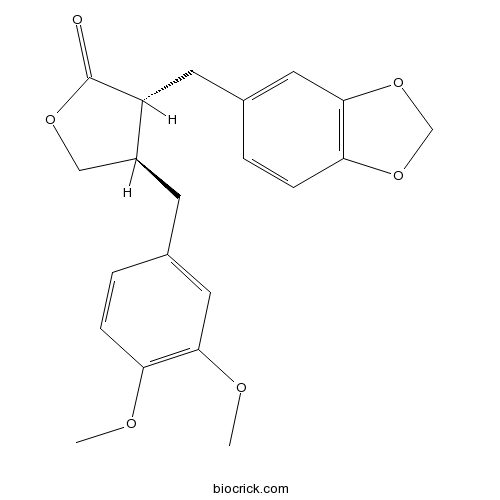KusunokininCAS# 58311-20-9 |

Quality Control & MSDS
3D structure
Package In Stock
Number of papers citing our products

| Cas No. | 58311-20-9 | SDF | Download SDF |
| PubChem ID | 384876 | Appearance | Cryst. |
| Formula | C21H22O6 | M.Wt | 370.4 |
| Type of Compound | Lignans | Storage | Desiccate at -20°C |
| Solubility | Soluble in Chloroform,Dichloromethane,Ethyl Acetate,DMSO,Acetone,etc. | ||
| Chemical Name | (3R,4R)-3-(1,3-benzodioxol-5-ylmethyl)-4-[(3,4-dimethoxyphenyl)methyl]oxolan-2-one | ||
| SMILES | COC1=C(C=C(C=C1)CC2COC(=O)C2CC3=CC4=C(C=C3)OCO4)OC | ||
| Standard InChIKey | LEVKKQBBEVGIKN-JKSUJKDBSA-N | ||
| Standard InChI | InChI=1S/C21H22O6/c1-23-17-5-3-13(9-19(17)24-2)7-15-11-25-21(22)16(15)8-14-4-6-18-20(10-14)27-12-26-18/h3-6,9-10,15-16H,7-8,11-12H2,1-2H3/t15-,16+/m0/s1 | ||
| General tips | For obtaining a higher solubility , please warm the tube at 37 ℃ and shake it in the ultrasonic bath for a while.Stock solution can be stored below -20℃ for several months. We recommend that you prepare and use the solution on the same day. However, if the test schedule requires, the stock solutions can be prepared in advance, and the stock solution must be sealed and stored below -20℃. In general, the stock solution can be kept for several months. Before use, we recommend that you leave the vial at room temperature for at least an hour before opening it. |
||
| About Packaging | 1. The packaging of the product may be reversed during transportation, cause the high purity compounds to adhere to the neck or cap of the vial.Take the vail out of its packaging and shake gently until the compounds fall to the bottom of the vial. 2. For liquid products, please centrifuge at 500xg to gather the liquid to the bottom of the vial. 3. Try to avoid loss or contamination during the experiment. |
||
| Shipping Condition | Packaging according to customer requirements(5mg, 10mg, 20mg and more). Ship via FedEx, DHL, UPS, EMS or other couriers with RT, or blue ice upon request. | ||
| Description | 1. Kusunokinin displays significant activity against intracellular amastigotes (IC(50) = 17 µM) and trypomastigotes (IC(50) = 51 µM) without hemolytic activity. |
| Targets | Antifection |

Kusunokinin Dilution Calculator

Kusunokinin Molarity Calculator
| 1 mg | 5 mg | 10 mg | 20 mg | 25 mg | |
| 1 mM | 2.6998 mL | 13.4989 mL | 26.9978 mL | 53.9957 mL | 67.4946 mL |
| 5 mM | 0.54 mL | 2.6998 mL | 5.3996 mL | 10.7991 mL | 13.4989 mL |
| 10 mM | 0.27 mL | 1.3499 mL | 2.6998 mL | 5.3996 mL | 6.7495 mL |
| 50 mM | 0.054 mL | 0.27 mL | 0.54 mL | 1.0799 mL | 1.3499 mL |
| 100 mM | 0.027 mL | 0.135 mL | 0.27 mL | 0.54 mL | 0.6749 mL |
| * Note: If you are in the process of experiment, it's necessary to make the dilution ratios of the samples. The dilution data above is only for reference. Normally, it's can get a better solubility within lower of Concentrations. | |||||

Calcutta University

University of Minnesota

University of Maryland School of Medicine

University of Illinois at Chicago

The Ohio State University

University of Zurich

Harvard University

Colorado State University

Auburn University

Yale University

Worcester Polytechnic Institute

Washington State University

Stanford University

University of Leipzig

Universidade da Beira Interior

The Institute of Cancer Research

Heidelberg University

University of Amsterdam

University of Auckland

TsingHua University

The University of Michigan

Miami University

DRURY University

Jilin University

Fudan University

Wuhan University

Sun Yat-sen University

Universite de Paris

Deemed University

Auckland University

The University of Tokyo

Korea University
- Nanaomycin C
Catalog No.:BCC4016
CAS No.:58286-55-8
- Kakkalide
Catalog No.:BCN8263
CAS No.:58274-56-9
- ICA 069673
Catalog No.:BCC7911
CAS No.:582323-16-8
- BMS265246
Catalog No.:BCC3741
CAS No.:582315-72-8
- Betulin palmitate
Catalog No.:BCN5792
CAS No.:582315-55-7
- Tetraethyl ranelate
Catalog No.:BCC9177
CAS No.:58194-26-6
- H-DL-Ser-OMe.HCl
Catalog No.:BCC3100
CAS No.:5819-04-5
- Idebenone
Catalog No.:BCC4913
CAS No.:58186-27-9
- Ethyl 5-amino-4-cyano-3-(2-ethoxy-2-oxoethyl)thiophene-2-carboxylate
Catalog No.:BCC8975
CAS No.:58168-20-0
- Militarine
Catalog No.:BCN2551
CAS No.:58139-23-4
- NSC 207895 (XI-006)
Catalog No.:BCC2243
CAS No.:58131-57-0
- 2-Hydroxynaringenin
Catalog No.:BCN4820
CAS No.:58124-18-8
- Saikosaponin B2
Catalog No.:BCN5916
CAS No.:58316-41-9
- Saikosaponin B3
Catalog No.:BCN8178
CAS No.:58316-42-0
- 4,4'-Bis(N-carbazolyl)-1,1'-biphenyl
Catalog No.:BCC8660
CAS No.:58328-31-7
- Isopimaric acid
Catalog No.:BCN4618
CAS No.:5835-26-7
- DL-Demethylcoclaurine
Catalog No.:BCC8317
CAS No.:5843-65-2
- Dihydroresveratrol
Catalog No.:BCN5793
CAS No.:58436-28-5
- H-2-Nal-OH.HCl
Catalog No.:BCC3287
CAS No.:58438-03-2
- Boc-2-Nal-OH
Catalog No.:BCC3289
CAS No.:58438-04-3
- Angiotensin 1/2 (1-5)
Catalog No.:BCC1035
CAS No.:58442-64-1
- H-D-Leu-OMe.HCl
Catalog No.:BCC2681
CAS No.:5845-53-4
- N-(2-Hydroxy-4-methoxyphenyl)acetamide
Catalog No.:BCN1409
CAS No.:58469-06-0
- Darlingine
Catalog No.:BCN1906
CAS No.:58471-10-6
Antitrypanosomal activity of a diterpene and lignans isolated from Aristolochia cymbifera.[Pubmed:20301059]
Planta Med. 2010 Sep;76(13):1454-6.
Bioguided fractionation of extract from the leaves of Aristolochia cymbifera led to the isolation of the furofuran lignans fargesin, epieudesmin, and sesamin; the dibenzylbutyrolactone lignans hinokinin and Kusunokinin; and an ENT-labdane diterpene named copalic acid. Our data demonstrated that copalic acid and Kusunokinin were the most active compounds against trypomastigotes of Trypanosoma cruzi. Additionally, copalic acid demonstrated the highest parasite selectivity as a result of low toxicity to mammalian cells, despite a considerable hemolytic activity at higher concentrations. Among the isolated compounds, Kusunokinin could be considered the most promising candidate, as it displayed significant activity against intracellular amastigotes (IC(50) = 17 microM) and trypomastigotes (IC(50) = 51 microM) without hemolytic activity. Fargesin, hinokinin, epieudesmin, and sesamin were also effective against trypomastigotes, but these compounds were highly toxic to mammalian cells and no parasite selectivity could be identified. The need for novel drugs for American trypanosomiasis is evident, and these secondary metabolites from A. cymbifera represent a useful tool for drug design.


